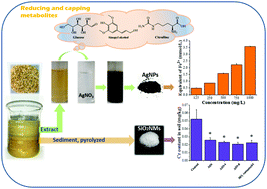Thorough utilization of rice husk: metabolite extracts for silver nanocomposite biosynthesis and residues for silica nanomaterials fabrication†
Abstract
Rice husk (RH), a low-cost agricultural waste material, contains valuable minerals, compounds and molecules, such as amino acids, sugar, lignin, cellulose and silicon. There is currently no approach to make complete use of these resources. In this study, the metabolites in RH were utilized for green synthesis of silver nanoparticles (AgNPs). Meanwhile, the residue was used to fabricate silicon dioxide nanomaterials (SiO2 NMs). We used gas chromatography-mass spectrometry (GC-MS) based metabolomics to elucidate the underlying mechanism for AgNPs formation. A total of 340 metabolites have been identified and quantified in the RH extracts. By comparing the concentration of metabolites before and after the reaction, approximately 39 metabolites responsible for the synthesis were screened out. Interestingly, six alcohols, six sugars and sugar derivatives, seven amino acids, eight organic acids, four fatty acids, and eight medicinal compounds, including xylitol, sinapyl alcohol, levoglucosan, glucose, carbamoyl-aspartic acid, citrulline, maleimide, phytol, and acetanilide, were markedly decreased or almost disappeared after the reaction, indicating that these compounds played reducing or capping roles during the NPs formation process. The obtained AgNPs exhibited strong antioxidant capacities. The biosynthesized SiO2 NMs were used to remedy heavy metal-contaminated soil, and the results of inductively coupled plasma-mass spectrometry (ICP-MS) analysis indicated that the biosynthesis mesoporous SiO2 NMs obtained from RH reduced the bioavailability of Cr, Cu and Cd significantly. The study provides a comprehensive view of how to utilize RH in a sustainable manner.



 Please wait while we load your content...
Please wait while we load your content...